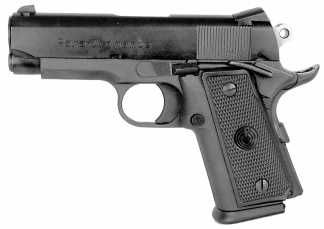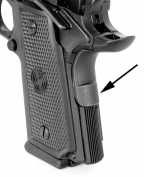Courtesy Gun Tests

Small semiautos that match the physical dimensions of pistols we tested recently – such as Para-Ordnances $740 P12-45 – are usually referred to as compacts or sub-compact. But when pistols of this size class are miniaturized 1911s, the tag of Officers models is hung on to them, even though they may not exactly fit the mold of the original Colts Officers model.
Manufacturers are taking a fresh look at the Officers model for a number of reasons. For one, the 1911 pistol has legions of fans inside both competitive shooting and law-enforcement circles. Traditionally the Officers model offered a six-round magazine, like the 945s. However, the Para Ordnance P12 integrates a double-stack or staggered-round magazine that in civilian trim will hold the full ten-round legal limit.
Courtesy

The P12 has been around a while and is essentially bug free. It fits the hand surprisingly well and points easily. Function was 100 percent despite warnings from some gunsmiths who seem weary of semiautos fitted with short slides. The P12 action also includes a Series 80-style firing pin block. This mechanism is not a favorite with 1911 purists, and some gunsmiths have a difficult time refining the action with this feature in place. But the P12 did not suffer any malfunctions because of it.
Our only complaints were the trigger. It was smooth but heavy, and this, coupled with a front sight blade that was too tall (approximately 0.153 inch) made for hits that printed low. We felt that having to hold the muzzle up when firing offhand was also having a negative effect on trigger feel, but each of these complaints should be easily remedied.
A coupon for one 12-round magazine from the factory is included along with one 10-round magazine. The supplied magazine comes with a base pad that offers a small forward lip that does add control without getting in the way of concealment. The aforementioned sights are a three-dot design, highly visible with the rear unit in the configuration of the (Richard) Heinie Slant-Pro. This means the face of the unit is slanted forward to offer better concealment. To ward off glare, the surface that faces the shooter is lined, and its profile is rounded for snag-free handling.
Another feature that only a short time ago was a custom part is the Ed Brown Memory Groove grip safety. This raises the area so that contact and compression is sure to deactivate the grip safety and enable the gun to fire.
Unlike the Smith & Wesson 945, the P12 was the only gun in the test that did not require special attention to placement of the web of the hand to make the gun go bang. The plastic grip panels are extremely thin and give the receiver a solid look and feel, but from there on no attempt was made to make the P12 look fancy. For example, Para Ordnance could easily charge more for the P12 if only it had a skeletonized trigger and enlarged the hole in the hammer tang, even if such modifications did nothing to enhance performance. Slide serrations are rearward only, which in our opinion is just as well given its small size. Using any other method other than the pinch technique to rack the slide or check the chamber would likely place the hand over the ejection port or in front of the muzzle. Checkering on the front strap might be a worthwhile addition.
At the bench our P12 turned out to be an old-fashioned 1911, meaning it favored the venerable 230-grain roundnose ammunition. While it did turn in a very good 2.1-inch average firing the 185-grain FMJ round, the combination of the P12 and Winchesters 230-grain FMJ brought us groups ranging from 0.8 inch to only 1.1 inches for an average of 0.9 inch at 15 yards. This was very reassuring. Results when firing the 185-grain SilverTip rounds were low on everyones scorecard, but the P12 handled them as well as the Smith Wesson pistol with average group sizes right at 3.3 inches. The P12 produced more velocity than its competitors, as much as 862 fps when firing the 185-grain Winchester Silvertips. This results in the production of 305 foot-pounds of muzzle energy. Comparing our Officers models to the full-sized pistols we evaluated in our May issue, subtracting about 1 inch of barrel length did little to handicap velocity or power. Firing this same round, velocity ranged from 867-897 fps in the big guns, compared to a range of 836-862 fps in our Officers pistols. It would seem that after 3 inches of barrel length, each additional inch of barrel length produces roughly 30 fps.
Lockup on the P12 was solid, with only a hint of play achieved with the use of a conical barrel matched to a bushing. The guide rod is a full-length two-piece affair. Would trigger work have improved our results? Possibly. But we would have to say that the biggest gain after action work would be seen from the standing position rather than from a sandbag rest. The standard trigger was more of a detriment to offhand shooting, where we found it more difficult hold the gun steady while controlling the trigger. Besides a weighty 8-pound pull, the standard trigger has a little up-and-down slop that just adds one more item to deal with.
One item that should not be overlooked is how much a pistol weighs when loaded. Naturally, a standard alloy Officers model with only 6+1 rounds aboard will be lighter than a pistol that accepts ten in the magazine. With ten rounds of 230-grain FMJ, the P12 weighs 36 ounces. Contrast these numbers to an all-steel model we have in house. A Springfield V-10 with an extra-capacity single-column seven-round magazine from Wilson Combat ([800] 955-4586) stoked with the 230 FMJs weighs more than 40 ounces. The P12 may be hard to beat.





















I own a P12 in steel. I bought new…. It is my daily carry gun in a Kramer Holster and Belt. This has never failed to do anything. I would go into hell with it.